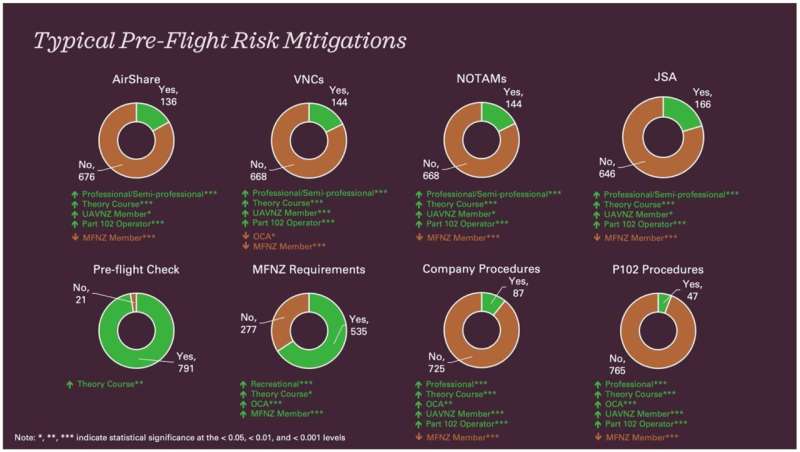FEBRUARY 15, 2022 by Massey University

A recently published study has found that users of unmanned aircraft, also known as drones, need to take a more holistic approach to identifying and mitigating potential risks before undertaking a flight.
A recently published study has found that users of unmanned aircraft, also known as drones, need to take a more holistic approach to identifying and mitigating potential risks before undertaking a flight.
The study, authored by School of Aviation lecturer Dr. Isaac Henderson, examined the prevalence of key operational risk mitigations amongst 812 users of unmanned aircrafts (also known as drones) in New Zealand, their confidence in identifying and complying with airspace requirements, and their ability to read Visual Navigation Charts (VNCs) and use AirShare (a tool that shows airspace requirements).
The study found that the only risk mitigation that virually all users applied was conducting a pre-flight check of their aircraft. However, less than a quarter of users typically log their flights on AirShare, check the VNC for the area of operation (useful for seeing airspace requirements and potential dangers in the operating area), check Notices to Airmen that have been issued (these contain aeronautical information that is time-sensitive), or conduct a Job Safety Assessment of the operating area (where you consider potential ground-based and airborne risks in the area and how they will be managed operationally).
Just over a quarter used air band radio to help enhance awareness of what was happening in the airspace around them. While a majority of users did typically apply Model Flying New Zealand (MFNZ) site-specific requirements, these are only applicable when operating at MFNZ sites, which are identified on VNCs so that manned aircraft pilots are aware of the potential for aeromodellers to be flying in the area. Outside those sites, other risk mitigations also need to be applied to ensure that airspace requirements are adhered to and risks are adequately managed.
Dr. Henderson says that users should view risk mitigation more holistically. “It was surprising to see such a low number of users applying risk mitigations where they check airspace requirements or actively consider airborne and ground-based risks. While many in the sample were MFNZ members who followed their own internal procedures for operating at their own sites, it is important that other risk mitigations are applied when operating outside of those sites.”
As for unmanned aircraft users who are not MFNZ members, Dr. Henderson has a clear message: “Mitigating risk is not simply a case of checking the aircraft is airworthy. That’s a great start, but even an airworthy aircraft can cause damage, injury, or disruption if the pilot operates it without being aware of the airspace requirements or considering how to minimize risks to people and property.”
The study also showed that users were confident in their ability to identify and comply with airspace requirements. Participants who indicated they knew how to use AirShare or read a VNC were asked two follow-up questions to measure their accuracy at using these tools. For both AirShare and VNCs, roughly half the participants got both questions correct, meaning that the other half were not entirely accurate when using these tools. However, those who indicated higher levels of confidence at identifying and complying with airspace requirements were typically more accurate than those with lower confidence levels.
Because users were grouped according to particular characteristics, there are some clear ways forward for improving the number and variety of risk mitigations applied. Having attended a course on unmanned aircraft operations had the strongest effect and improved risk mitigation across all measures (number, variety, confidence, and accuracy).
A weaker effect was also found with operational competency assessments, a form of flight examination to ensure practical competency. Dr. Henderson says it appears that the key way of increasing the number and variety of risk mitigations a user typically applies is through education, suggesting that educational requirements may be a suitable policy direction.
Professional and semi-professional operators, members of Unmanned Aerial Vehicles New Zealand (a professional and industry body), and those that operated for Part 102 organizations (organizations that have been certificated by the Civil Aviation Authority to undertake operations that would not be allowed under general operating rules for unmanned aircraft) also typically apply more risk mitigations.
Dr. Henderson says he has an idea why this might be the case. “This is presumably because their livelihoods depend upon safe operations and because there is a greater reputational risk and potential for accountability for these operators than with other users.”
He says the study is the first of its kind in the world by examining risk mitigation for unmanned aircraft operations from a user perspective.
“There is little in the academic literature about how users are currently mitigating risks. While there are many papers that examine risk mitigation, they tend to take the view of what users should be doing rather than examining what they are doing. Without knowing what is happening now and understanding differences between users, it will be difficult to bridge that gap.”
Ultimately, Dr. Henderson says that while the risk posed by unmanned aircraft is generally low, there is always potential for an incident or accident if users are not applying a variety of risk mitigations. He hopes that the study will spur future research and regulatory work on this issue.
More information: Isaac Levi Henderson, Examining New Zealand Unmanned Aircraft Users’ Measures for Mitigating Operational Risks, Drones (2022). DOI: 10.3390/drones6020032
Provided by Massey University
